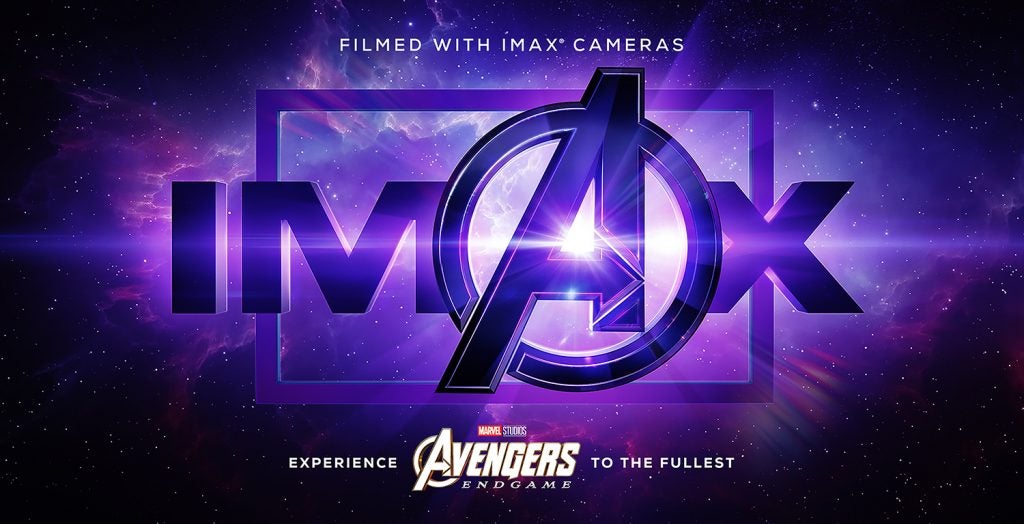Why IMAX is the biggest game in town: Interview with CTO Brian Bonnick

IMAX has come on leaps and bounds in the past 20 years, transitioning from film to digital, embracing Hollywood blockbusters and becoming the format on which to watch the biggest films on the biggest screen around.
With Avengers: Endgame out in cinemas – the second film following last year’s Infinity War to be shot entirely with IMAX digital cameras – we talked to chief technology officer, Brian Bonnick, about the reasons filmmakers choose to shoot in the format IMAX Laser, how it’s competitors match up, and why IMAX remains the biggest game in town.
Here’s our interview with Mr Bonnick, edited for clarity and length, as we caught up with him a few days before Avengers: Endgame broke worldwide box office records, with a new IMAX all-time opening weekend total of $91.5 million.

IMAX chief technology officer, Brian Bonnick
TR: So Brian, easy question or maybe not. You’ve been working at IMAX for almost 20 years and seen the format develop hugely. What’s it been like to experience that from the inside?
BB: Totally stressful [laughs]. Actually, that isn’t entirely untrue; it’s been really exciting. When I joined the company 20 years ago, we were strictly film-based, which was cool on its own. But I’ve been with the company through the entire transition to digital, in our digital remastering technology, sound systems and projection systems. So it’s almost like a baby for me in that it’s kind of grown up and I’ve been lucky enough to have been a part of it. It’s actually been a lot of fun.
TR: It’s grown massively over the past 20 years. There’s 15/70mm theatres, IMAX Laser and IMAX Digital. What’s the difference between the formats?
BB: Well, they’re each very different. Film unto itself is very different than digital, and I think each medium has its pros and cons – not necessarily meaning good or bad, but more so for the viewers.
You have some viewers who are film fans, alongside younger people who have grown up in the digital era, who embrace digital and may not even know what film is. As such, you have a different set of clientele.
Technically, film still carries the highest resolution in the industry, but you have digital systems that can achieve higher contrast than film. There are technical plus points to each system, each technology.
TR: So with regards to the filmmaking process, do filmmakers come to IMAX or does IMAX pitch to filmmakers?
BB: That’s an interesting question. Ten years ago, we’d probably pitch to filmmakers – for Hollywood based films; we were like the little kid sitting at the little kid table at a party. It’s all switched around now. We’re sitting at the head table at the event, with filmmakers coming to us. We’re having to pick which films we want as opposed to begging for films, and that’s great because we’re all about doing blockbuster films.
As a result of that we tend to get the very best of film, which inherently means you get the very best filmmakers, too. They really understand their craft, both creatively and technically, so it makes it a really good match in that respect.

TR: So what is the process like for producing an IMAX film, especially with regards to Infinity War or Endgame, where they’re of huge scale?
BB: This is the second film the Russo brothers have filmed entirely with IMAX cameras. Their mindset was to be able to bring this film to the IMAX venue at that 1.9 aspect ratio, so there’s 26% more content on IMAX than you’re going to find on any other screen.
The filmmakers – particularly those who have worked with IMAX a few times now – understand how to use our cameras; they understand that with sound, for example, we go an entire octave lower.
When they’re capturing their movie, they’ll take those additional attributes into account, because in the past they were limited. For example, with a rocket ship or a volcano erupting, in a normal theatre you’ll hear a nice low rumble. In IMAX you not only hear it, you feel it.
These filmmakers are familiar with what the technology is capable of and, in many cases, they’ll take advantage of that and use it creatively to tell the story in a more compelling and immersive manner.
TR: Hollywood has moved its workflow towards digital, so in terms of IMAX do you see filmmakers opting for digital over film – or will there be a mix of both?
BB: As long as film is around there will always be a mix of both; there isn’t a right or a wrong. It’s very much tied to the filmmaker: how they want to tell a story, the nature of the content, even down to the nature of a particular scene – in certain scenes you might be limited by the size of a camera. You may have to use a GoPro for a certain shot, so there’s a lot of factors that come into play when they make that choice.
The other side of that equation is the way in which filmmakers capture. We get many that capture in film, but present in digital and maybe film as well. What we do, which is very different to what everybody else does after capturing in film – and IMAX film cameras can capture at 18K film resolution – is that we convert that into digital at the highest possible resolution and work with that throughout the entire process. Only at the last minute do we convert it to 4K; others start off at 4K because it’s cheaper.
The benefit we have is a technique called oversampling. In really simple terms it means that if you’re doing everything in post-production with way more data, even though the display medium is 4K, you’re going to end up with a better product, a better-looking image by maintaining that high resolution as far as you can.
The other element is our DMR technology (Digital Media Remastering). When you’re thinking about taking content and blowing it up onto the IMAX screen, you’re also blowing up every single tiny little artefact. As a result, if you don’t do something then this, too, becomes more apparent, and that’s where DMR comes in.
It’s a temporal process and it looks at multiple frames and is able to discern what is an artefact, what is real content, what is grain and what is not. If you’re dealing with film versus digital cameras, you have film grain or digital noise. It’s able to remove those artefacts, and enhance sharpness and contrast.
We don’t do that for the filmmaker; we work with them. Their content is their baby, so when it comes to us we’ll take a pass at it and they’ll come to our theatre (we have a full-sized theatre in our offices) sit down and give them the volume knobs, so to speak. They get to watch their content and they’re able to dial in the enhancements they want. That’s very much a non-technical thing; it’s a creative thing – do I want more grain, do I want less grain? Do I want the image sharper; do I want it less sharp?
We give the filmmakers the tools within our system to be creative, and it works really well because it allows us to develop a trust, a very strong relationship and transparency with the filmmaker. It lets them feel much more comfortable working with us, because filmmakers generally don’t like others touching their content. As such, we’ve taken an approach of “let’s pull them into the fold” because the more we let them do in it, the better the gains in terms of the end product.
Related: The definitive ranking of the Marvel Cinematic Universe movies − From worst to best
TR: Audio is as important as visuals and IMAX can go very loud. What goes into producing a soundtrack for an IMAX film and getting all the detail and dynamics right?
BB: Well, IMAX soundtracks are custom processed; the big difference is we have ten times the dynamic range compared to other systems. In addition, as mentioned we go an entire octave lower at the low-end, enabling us to get to 23Hz and below easily. Other systems roll off in the best of cases at about 40Hz.
The other advantage of our sound system is that it’s 12-channel (12 loudspeakers); and the biggest task of the post-production house is management of bass, because we can go much lower.
Our amplifiers put out thousands and thousands of watts, but the intention isn’t to play it loud. We’re putting out on average 300-watts at a time – that’s a relatively low number. The horsepower is there when you hit a situation: where a rocket ship takes off, for example. Unlike other systems, we want to reproduce that sound in the way it was intended, which means it requires massive amounts of power – not necessarily volume – but we do’t want distortion.
As a result, you need amplifiers that are heavily overrated to reproduce those peaks without distortion – and to be very blunt, other systems can’t do that because they’ve got 20, 30, 40 loudspeakers in the theatre so they can’t afford to spend money on custom amplifiers and loudspeakers in the way we can.
The other area that we focus on is that through our loudspeakers (all of the IMAX hardware is custom designed) is the creation of phantom imaging, which is also managed in the post-production house.
Basically, we don’t need 60 loudspeakers to make sound appear as if it’s coming from all over the theatre. We can actually create a phantom image at a point, so long as it’s between two or three loudspeakers within that envelope in the theatre, and we can make the sound feel as if it’s coming from a spot where there actually is no loudspeaker. That’s a combination of post-production tools coupled with the design of the physical loudspeaker.
In addition, we have three microphones permanently mounted in the theatre and, every morning, when the system powers up we run a custom set of tones through the theatre to validate that every single loudspeaker and every driver in that loudspeaker is working properly: that the frequency response, the timbre, the volume, everything is balanced in the way it’s supposed to be.
And if it isn’t, the system sends an alert back to our network operations centre. To give you an example: in some movies, a spaceship movie where there’s a rocket ship going off, the drivers – the cone, if you will – fail from time to time, so we could have one of the cones in one of eight sub-bass fail. The system will recognise that; it will boost the power to the other seven sub-bass and turn that failing one off so there’s no distortion and then send us an alert.
You want to know you’re getting something different, and the one way we make sure that happens is by ensuring that every single day the brightness is what it’s supposed to be, the contrast is where it’s supposed to be, and the sound is where it’s at. That’s something nobody else in the industry does.
TR: So, in that respect, what are your thoughts on Dolby Cinema and THX Ultimate?
BB: I think Dolby Cinema has got a good system on a sound base by going with Dolby multiple loudspeakers. It’s able to create, quite nicely, sound coming from different locations, so I give the company great credit for that.
The THX experience, and a lot of what I’ll call the other “XYZ”-branded theatres, are taking standard off-the-shelf projectors, a sound system and a larger screen, and placing them into a theatre and calling it something special – and I think it’s probably only a little better than a standard setup.
On the other hand, we’re acoustically treating the theatre to ensure a very specific reverberation profile; we’re acoustically treating it to get to a very low noise level in order to achieve a substantially higher dynamic range. We’re putting in custom componentry top to bottom.
So while these other systems are good, we’re building ourselves a Ferrari here. We’re doing that so you get an elevated experience. So while I think what they’re all doing is really good stuff, in fairness we’re taking this a whole notch higher.
We have the DMR technology that others don’t. We have our radical in-house laser projection system – it cost us $16 million to design – that gets rid of the prism issue that affects sharpness, contrast and convergence that all these digital projectors suffer. We’ve been able to eliminate those problems.
We use custom lenses, and I’m talking expensive lenses with very little glass in them. Most of the projection lenses in the marketplace feature a greater proportion of glass, and the more glass you have, the greater your ability – and I don’t mean this in a good way – to affect the quality of the image going through the lens.
You’re diffracting more of the component and therefore creating more artefacts. By cutting down the amount of glass in your entire projection system, and having the image go through fewer layers of it, you achieve a much more realistic and pristine image on the screen.
Related: Behind the scenes of Dolby Cinema at the Odeon LUXE Leicester Square
TR: Do you see Dolby Cinema and THX as threat, or see the competition as a positive?
BB. No, neither are a threat. First, there’s a market opportunity for them out there. Two, there have been exhibitor custom theatres venues such as RPX (Regal Premium Experience), UltraAVX [both in the US] for many years now, and they’re not particularly affecting our market opportunity. There’s a space for them and a space for us.
I use the analogy of an airplane, in which you have Coach, Business and First class. They’re trying to approach the Business class, which is great; there’s a clientele for that. We’re approaching First class and there’s a clientele for that too.
I think it’s complimentary. In fact, I believe they help us, because there’s such a vast difference in the overall experience given all the attributes that IMAX brings to the equation: the fact that we’re working with the filmmaker, the fact that in films [such as Endgame] you’re getting that extended audio with the low end, that 1.9 aspect ratio so you’re getting 26% more image and only in IMAX.
In my opinion, all of those things working together still clearly differentiates the IMAX experience.
Related: ScreenX cinema − like IMAX but sideways
TR: Is IMAX Enhanced there just to bring the IMAX experience to the home? Or is it to spread the brand even further, or both?
BB: think it’s a combination of both. It’s a natural progression for us. We’ve been very successful in what I call our core business on the theatrical side, and as a company that wants to grow and expand, it’s a natural progression to want to move into other market applications and marketplaces. We’re always looking for new market opportunities and this is just one of them. It’s a very fitting one because we can bring the cinema experience and many of those elements to the home.
We’re taking Hollywood movies and digitally remastering the content for home application. By working with partners such as Integra, Lexicon, Sony, Pioneer, with their top of the line components – their AVRs and TVs – which can accommodate our technology, we’re reproducing the experience. I think it’s very much a synonymous thing for both sides of that equation.

TR: Final question – what’s the best way to enjoy Endgame in IMAX? LASER, 3D?
BB: It’s a personal thing. I like 2D; I’m not a big lover of 3D, but the next guy might love 3D.
I think the IMAX Laser is literally leaps and bounds above any other technology in the marketplace right now. It’s the sharpest image in the industry, with every single pixel showing up on-screen.
A lot of people say, we’ve got a 4K projector, but that doesn’t mean every single pixel shows up with clarity on the screen; it just means you’re shooting 4K pixels out the window and it’s a very different thing that shows up on the screen. I’d recommend you go see it in IMAX Laser.
So there you have it. If you’re one of the few who haven’t seen Endgame yet, IMAX Laser is the best bet for the full cinematic experience.


